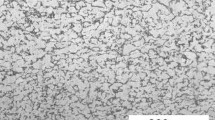The influence of chromium (0.5-8 at.%) on the oxidation resistance of binary Ti and Zr alloys at 500–700°C and 50 h holding is investigated. It is shown that the oxidation of these alloys is described by a parabolic-law function at 500–600°C and a linear function at 700°C. It is established that 8 at.% Cr decreases the high-temperature oxidation resistance of titanium by 50–67%, but the chromium content up to 4 at.% hardly influences that of zirconium. Higher chromium concentrations also decrease the oxidation resistance. The results for titanium are attributed to specific chemical interaction of titanium and zirconium oxides and for zirconium to the structural factor associated with the formation of brittle ZrCr2 intermetallide.
Similar content being viewed by others
References
J. Benard, Oxidation of Metals [in French], Gauthier-Villars, Paris (1964).
M. Hansen and K. Anderko, Constitution of Binary Alloys, McGraw-Hill, New York (1958).
I. I. Kornilov, Titanium [in Russian], Nauka, Moscow (1975), p. 308.
A. V. Nikulin, “Zirconium alloys in nuclear energy,” Metalloved. Term. Obrab. Met., No. 11, 8–12 (2004).
V. N. Eremenko, Titanium and Its Alloys [in Russian], Izd. AN USSR, Kiev (1960), p. 510.
V. N. Eremenko, “Constitutions and properties of titanium–chromium alloys,” in: Problems of Physical Metallurgy and Thermal Treatment [in Russian], Izd. AN USSR, Kiev (1954), pp. 40–66.
R. F. Voitovich and É. I. Golovko, High-Temperature Oxidation of Metals and Alloys [in Russian], Naukova Dumka, Kiev (1980), p. 296.
V. I. Nikitin, Calculation of Oxidation Resistance of Metals [in Russian], Metallurgiya, Moscow (1976), p. 207.
A. P. Zefirova (ed.), Thermodynamic Properties of Inorganic Substances [in Russian], Atomizdat, Moscow (1965), p. 459.
Phase Diagrams of Refractory Oxides. Binary Systems: Handbook [in Russian], Nauka, Leningrad (1988), Issue 5, Part 4, p. 345.
I. V. Oryshich, N. E. Poryadchenko, and N. P. Brodnikovskii, “High-temperature oxidation of intermetallics formed by group IV transition metals with chromium,” Powder Metall. Met. Ceram., 43, No. 9–10, 497–503 (2004).
Author information
Authors and Affiliations
Corresponding author
Additional information
Translated from Poroshkovaya Metallurgiya, Vol. 49, No. 7–8 (474), pp. 107–115, 2010.
Rights and permissions
About this article
Cite this article
Brodnikovskii, N.P., Oryshich, I.V., Poryadchenko, N.E. et al. Resistance of titanium– chromium and zirconium–chromium alloys to air oxidation. Powder Metall Met Ceram 49, 454–459 (2010). https://doi.org/10.1007/s11106-010-9257-x
Received:
Published:
Issue Date:
DOI: https://doi.org/10.1007/s11106-010-9257-x




